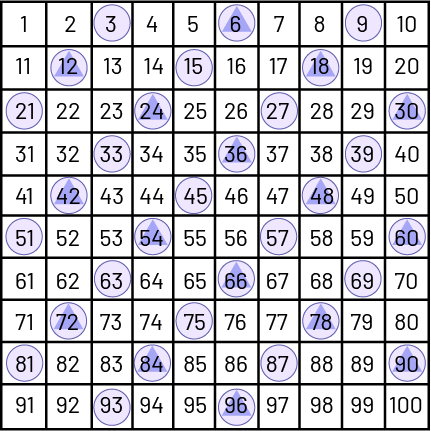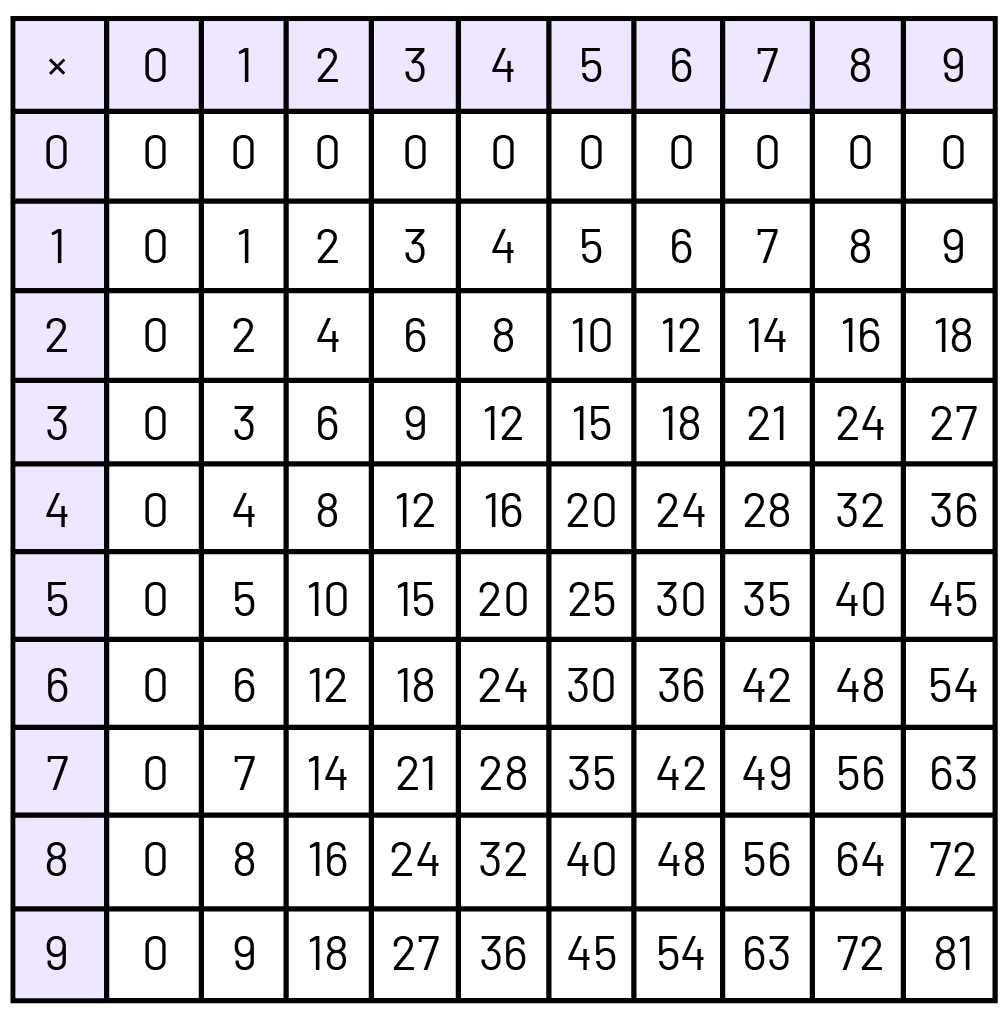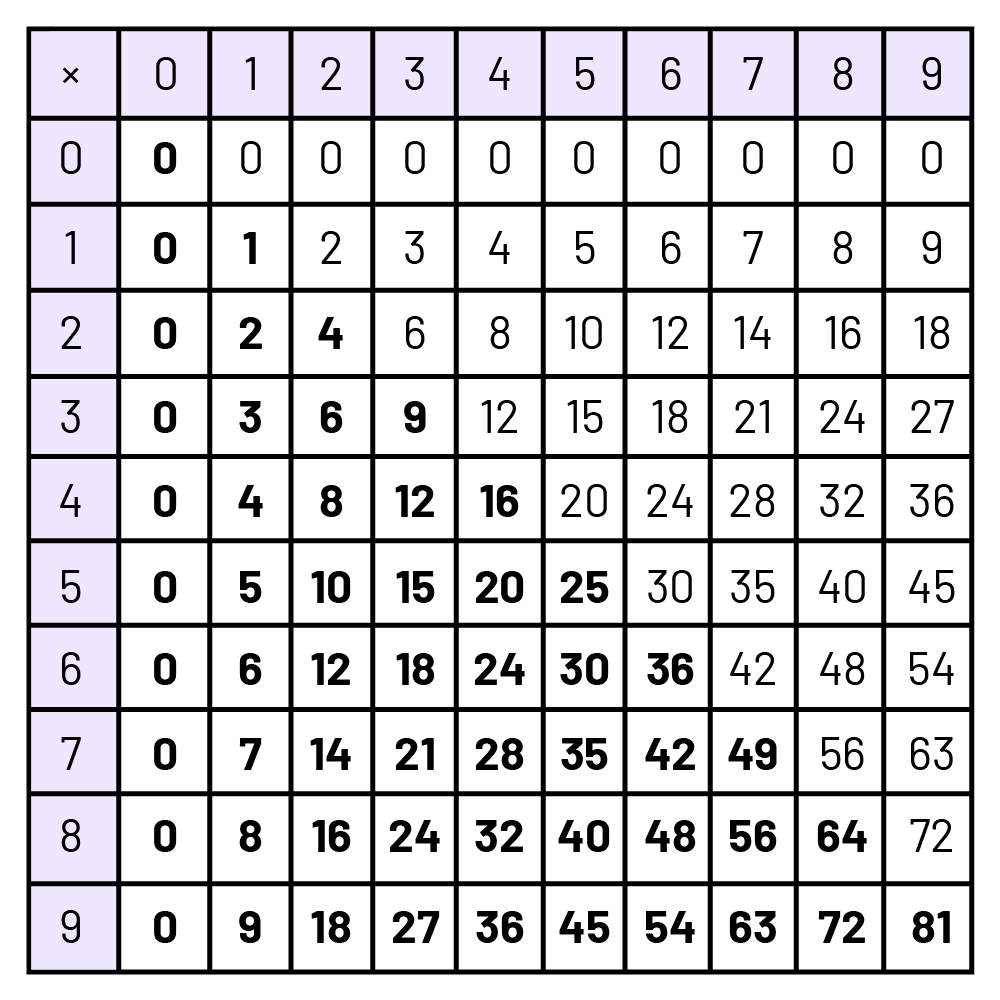B2.2 Recall and demonstrate multiplication facts for 1 × 1 to 10 × 10 and related division facts.
Skill: Demonstrating Understanding of Multiplication and Division Facts
Learning basic multiplication and division facts is a must. They are the foundation for operations and an essential tool for working with larger numbers. It is important that students learn to master basic number facts.
However, there are teaching strategies that allow students to learn them. Facts do not have to be memorized by repeating them and using flashcards. This approach, which involves memorizing the facts as distinct pieces of knowledge, requires the memorization of nearly 400 isolated facts. It is very demanding on the memory, since learning the facts is not based on making connections.
Instead, learning number facts must build on students' ability to make connections and on their prior knowledge. The role of teachers is to present strategies and tools to students. For example, to learn multiplication facts by 9, students can use the "it's a group less than" strategy: multiply the number by 10 and subtract a group. Thus, a student might hold the following reasoning:\(9\; \times \;8\), is like \(10\; \times \;8\; = \;80\), minus a group of 8, so it's 72. This strategy helps the student answer correctly and quickly and understand the quantities involved in this multiplication.
With practice, students use the strategies less and less and develop automaticity in finding many basic facts. Students may not be able to spontaneously state all of the answers to basic number facts, but can find them quickly using the learned strategies, as is the case with many adults who have excellent number sense.
In Grade 4, the multiplication facts are learned up to \(10\; \times \;10\).
The following list presents the most common strategies and properties for learning basic number facts. In general, not all students use the same strategies. Moreover, they do not use all of the existing strategies, but usually choose one or more, depending on their comfort and the number facts being addressed.
Source: translated from Guide d'enseignement efficace des mathématiques de la 4e à la 6e année, Numération et sens du nombre, Fascicule 1, Nombres naturels, p. 88-89.
Multiplication can be represented as repeated addition, arrays, or a set of equal groups.
Properties and strategies that support conceptual understanding of multiplication include:
- the identity principle of multiplication: (\(a\; \times \;1\) always equals a);
- the zero property of multiplication: 0 × a always equals 0;
- the commutative property \(\left( {2\; \times \;3\; = \;3 \times \;2} \right)\);
- the distributive property \(\left[ {5\; \times \;6\; = \;5\; \times \;\left( {4\; + \;2} \right)\; = \;\left( {5\; \times \;4} \right)\; + \;\left( {5\; \times \;2} \right)} \right]\) ;
- the associative property \(\left[ {5\; \times \;12\; = \;5\; \times \;\left( {2\; \times \;6} \right)\; = \;\left( {5\; \times \;2} \right)\; \times \;6} \right]\) ;
- that it is the inverse operation of division.
Division can be represented as repeated subtractions, equal distribution or sharing.
Properties and strategies that support conceptual understanding of division include:
- the identity principle states that when dividing an amount by 1, the amount stays the same (\(a\; \div \;1\) always equals a);
- the relationship between division and fractions (12 candies divided into 3 groups represent both \(12\; \div \;3\) and the whole divided into 3 equal parts);
- that it is the inverse operation of multiplication.
Source: translated from Guide d'enseignement efficace des mathématiques de la maternelle à la 6e année, Numération et sens du nombre, Fascicule 1, Nombres naturels, p. 21-22.
Patterns in Numbers
Students develop a better understanding of the meaning of mathematical operations by exploring the patterns they generate in number sequences. They can use the number line or the hundreds grid to analyze the number sequences obtained when skip counting. For example, if one skip counts by 10s from any number from 0 to 9, all the results will end with that number, such as when one starts counting at 3 and gets the sequence 3, 13, 23, 33, 43…).
The study of patterns in number sequences also facilitates the learning of basic number facts (for example, all multiples of 5, that is 5, 10, 15, 20, 25…, end in 5 or 0) and the building of connections between numbers (for example, all multiples of 10[▲] are also multiples of 5[●] ).

… or, all multiples of 6 [▲] are also multiples of 3 [●]).

Students generally enjoy identifying patterns in the number sequences generated by mathematical operations, with each discovery usually evoking a sense of wonder. Activities related to finding patterns encourage students to juggle numbers and promote the development of divergent thinking and analytical skills, two important components of mathematical thinking. In addition, the ability to explore patterns is essential to the study of algebra and geometry.
Source: translated from Guide d'enseignement efficace des mathématiques de la 1re à la 3e année, Numération et sens du nombre, p. 30-31.
Strategies for Learning Multiplication and Division Facts
To learn the basic multiplication and division facts, it is not enough to memorize them. It is important to understand that these operations can be approached in different ways.
Basic Multiplication Facts
- The basic multiplication facts are all the multiplication facts from \(0\; \times \;0\) up to \(9\; \times \;9\).
- There are 100 basic multiplication facts.

Basic Division Facts
- The multiplication grid can also be used for division.
- The number facts of division are the inverse of the number facts of multiplication, from \(81\; \div \;9\) to \(1\; \div \;1\).
- There are 90 basic facts for division.
- There are no facts including 0 because it is impossible to use 0 as a divisor.

Models for Representing Basic Multiplication and Division Facts
Several models can be used to help students understand multiplication and division. They enable students to:
- grasp the meaning of operation symbols and make connections between drawings/pictures, words and symbols;
- understand the meaning of operations and use different representations - concrete, visual (semi-concrete) and symbolic.
Many models can be developed using the materials below to help students understand multiplication and division:
- concrete objects, such as counters, sticks, tiles, and various containers to place them in;
- interlocking cubes;
- visual material, such as illustrations;
- arrays;
- base ten blocks
- coins (1¢, 5¢, 10¢, 25¢, $1and $2);
- grid paper;
- number lines;
- hundreds charts.
Models of all kinds can help students make connections and thus better understand what the symbols represent in operations. Students need to work with representations that help them perceive relationships between multiplication and repeated addition, and between multiplication and division (students learning long division can also benefit from representations that help them perceive long division as repeated subtraction or repeated addition). Understanding of arrays as a multiplication or division tool develops with time and practice. Once students can picture facts such as \(5\; \times \;6\) using arrays, they can use these to find the answer to \(50\; \times \;6\), and so on.
Representations of all kinds help students make connections between patterns, symbols, and words. Below are different representations of the basic number fact \(2\; \times \;6\). Each of the 7 representations is appropriate. Remember that students feel less need to resort to visual representations as they develop some automaticity in solving basic number facts.

Source: translated from Guide d'enseignement efficace des mathématiques de la maternelle à la 6e année, Fascicule 5, p. 21-24.
Recall of Multiplication and Division Facts
Before they can learn multiplication and division facts, students need to understand how to make and count equal groups and how to divide a whole into equal groups. They also need to know how to skip count by 2s, 3s, 4s, 5s and 10s. The strategies for basic multiplication and division facts are intended to help students build on their prior knowledge and their previous experiences in order to learn to use these new strategies (for example, dividing into equal groups, counting in intervals…).
The following strategies are not presented in any particular order. Some students may find some strategies more useful than others, or may ignore some strategies in favour of their own. Others find it easier to memorize facts than to rely on a strategy. Whatever the case, the teacher's primary goal is to get all students to fully understand multiplication and division.
Commutative Property
Students benefit from experiences that help them recognize the commutative property of multiplication (\(2 \times 4 = 4 \times 2\)). Students who understand the commutative property can use half of the basic number facts to learn the other half.
Commutative Property Grid

Rules for 0 and 1
Students benefit from experiences that help them understand the Identity Principle which states that when multiplying or dividing an amount by 1, the amount stays the same (for example., \(1\; \times \;3\; = \;3, \;6\; \div \;1\; = \;6\)) and the zero property of multiplication which states that the product of a number multiplied by 0 is 0 (for example, \(100\; \times \;0\; = \;0\)). Experiences with problems, such as, "If I give you 3 packages of 0 cookies, how many cookies do you have?" are more helpful in understanding these rules than is rote practice.
Doubles
The multiplication facts of 2 should be linked to students' prior knowledge about the addition of doubles. This strategy is particularly helpful because students who know the facts of 2 well can relate these facts to the multiplication table of 3. If \(2 \times \;4\) is 8, then \(3 \times \;4\) is 8 plus one more 4.
Double and Double Again
Once students know the double facts (the multiplication facts of 2), they can apply this knowledge to the multiplication facts of 4. Any number times 4 is the same as double the answer to two times that number (for example, \(4 \times \;6\) is the same as double \(2 \times \;6\), with the answer 12 doubled 24).
(Van de Walle and Folk, 2005, p. 152)
Double and One More Set
Again, once students know the double facts (the multiplication facts of 2), they can use this information to figure out the multiplication facts of 3. If \(2\; \times \;4\;\) is 8, then \(3\; \times \;4\;\) is 8 plus one more 4 which is 12.
(Van de Walle and Folk, 2005, p. 152)
Five Facts
Students who have experience counting by fives and identifying the five fact patterns on a hundreds chart usually do not have difficulty learning the five facts. A wide variety of songs, poems, and storybooks based on fives are available that will support learning this strategy.
Add One More Set
If the student knows \(6\; \times \;7\; = \;42\), then they can figure out \(6\; \times \;8\) by adding one more 6 to the 42 to make 48 . This strategy is especially useful for the multiplication facts of 6, which can be difficult to recall. If the multiplication facts of 5 are well retained, students figure out the multiplication facts of 6 by simply adding one more group of the factor that is not the 6. For example, if \(5\; \times \;7\; = \;35\), then \(6\; \times \;7\) is simply 35 plus one more 7, or 42. (Van de Walle and Folk, 2005, p. 152). Similarly, if the student needs to find the product of \(8\; \times \;7\) and knows that \(8\; \times \;8\; = \;64\), they can use the same strategy in reverse, that is, subtract 8 from 64 to get 56.
The Facts of 9
Students often learn the multiplication facts of 10 quite easily because they learn to count by tens at an early age. Once they know the facts of 10, they can relate it to the multiplication facts of 9 by calculating the related ten times fact and then subtracting one of the group of the factor that is not the 9. For instance, if \(10\; \times \;8\) is 80, then \(9\; \times \;8\) is 80 less one 8, or 72.
Teachers can help students recognize some of the patterns in the facts of 9. For instance:
- all the digits in the products are equal to 9 if they are added together \(\left( {5\; \times \;9\; = \;45; and \;4\; + \;5\; = \;9} \right)\)
- the tens in the product are always one less than the multiplier. For instance, in \(6\; \times \;9\; = \;54\), the tens digit is 1 less than the multiplier of 6 (so 5), and the sum of the two digits in the product (5 and 4) is 9.

Some students find this kinesthetic method useful for remembering the table of 9. Students are asked to hold out their hands with their palms facing away from them. Their fingers ( (beginning at the left little finger) are numbered from 1 to 10 (A). The finger that represents the multiplier of nine is folded down. If multiplying 9 x 4, the fourth finger is folded down (B). The number of fingers to the left of the folded finger represents the tens digit. The number of fingers to the right of the folded finger represents the ones (C). So, in this instance, there are 3 fingers to the left of the four, representing 30, and 6 fingers to the right of the 4, representing 6, for a total answer of 36.
Half Then Double
Suppose a student cannot recall a fact and the fact involves even factors. One factor can be halved, and if that is known, the product can be found and then doubled. For instance, if \(6\; \times \;8\) cannot be recalled, halve one factor \(\left( {3\; \times \;8\; = \;24} \right)\), and then double the product of \(\left( {2\; \times \;24} \right)\) for an answer of 48. Students should investigate this strategy by using arrays to provide a visual presentation. Sometimes, the strategies may seem cumbersome, but they provide students with a way to reason their way to a correct answer using known facts. (Van de Walle & Folk, 2005, p. 152)

Source: translated from Guide d'enseignement efficace des mathématiques de la maternelle à la 6e année, Fascicule 5, p. 25-28.
Inverse Relationship of Division and Multiplication
Students who have mastered multiplication number facts should use this knowledge to discover division number facts. It is recommended that division and multiplication be taught simultaneously to highlight the relationships between the two. When students join 4 groups of 5 elements for a total of 20, teachers should encourage them to realize that when that total is again divided among 4 groups, each group has 5 elements.
Learning the Division Facts in Sequence
A suggested sequence for teaching division facts is to begin with facts for division by 2, then division by 1, by 5, by 3, by 4, by 6, by 7, by 8, and by 9.
Source: translated from Guide d'enseignement efficace des mathématiques de la maternelle à la 6e année, Fascicule 5, p. 29.
